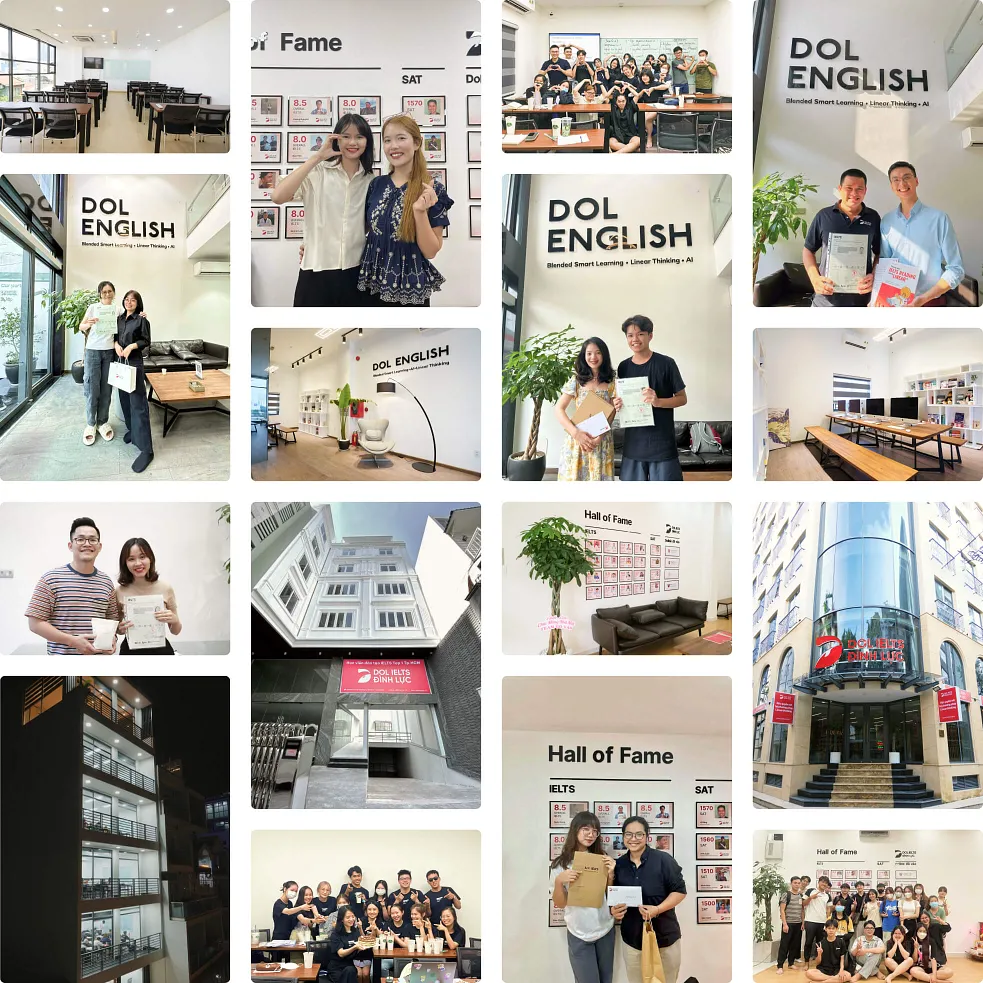Đề thi + Đáp án chủ đề advantages of public transport - IELTS Reading
DOL xin giới thiệu đến các bạn đề thi Reading IELTS thuộc chủ đề giao thông: "Advantages of public transport" nhé. DOL hi vọng đề thi này sẽ cung cấp cho các bạn thật nhiều kiến thức bổ ích.
DOL IELTS Đình Lực
Feb 01, 2024
2 mins read
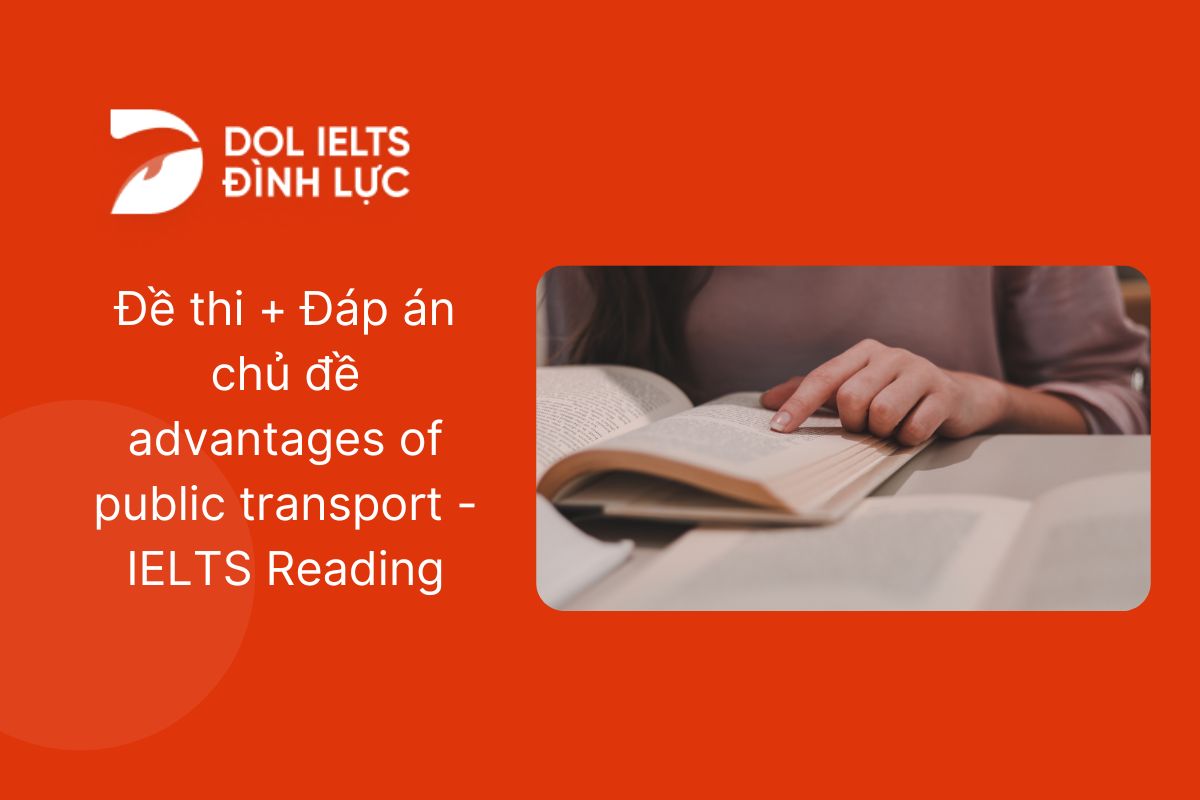
Table of content
Advantages of public transport
Answer key
Lời kết
Câu hỏi thường gặp
Advantages of public transport
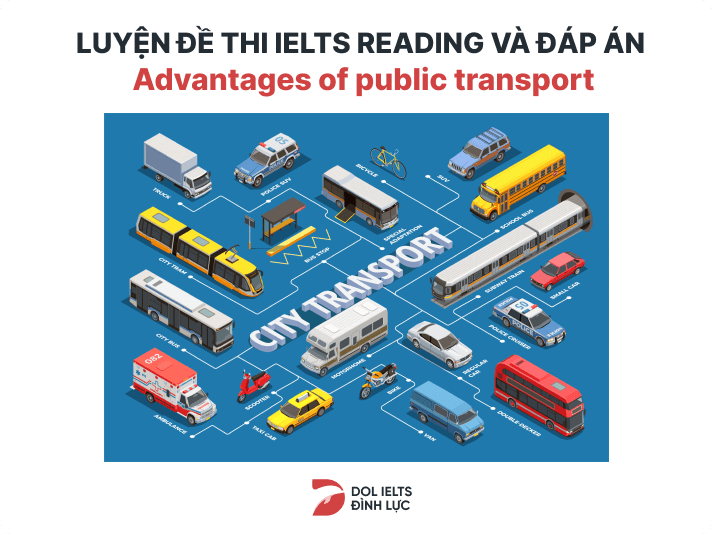
A New study conducted for the World Bank by Murdoch University's Institute for Science and Technology Policy (ISTP) has demonstrated that public transport is more efficient than cars. The study compared the proportion of wealth poured into transport by thirty-seven cities around the world. This included both the public and private costs of building, maintaining and using a transport system. The study found that the Western Australian city of Perth is a good example of a city with minimal public transport. As a result, 17% of its wealth went into transport costs. Some European and Asian cities, on the other hand, spent as little as 5%.
Professor Peter Newman, ISTP Director, pointed out that these more efficient cities were able to put the difference into attracting industry and jobs or creating a better place to live. According to Professor Newman, the larger Australian city of Melbourne is a rather unusual city in this sort of comparison. He describes it as two cities: 'A European city surrounded by a car-dependent one'. Melbourne's large tram network has made car use in the inner city much lower, but the outer suburbs have the same car-based structure as most other Australian cities. The explosion in demand for accommodation in the inner suburbs of Melbourne suggests a recent change in many people's preferences as to where they live.
Newman says this is a new, broader way of considering public transport issues. In the past, the case for public transport has been made on the basis of environmental and social justice considerations rather than economics. Newman, however, believes the study demonstrates that 'the auto-dependent city model is inefficient and grossly inadequate in economic as well as environmental terms'.
Bicycle use was not included in the study but Newman noted that the two most 'bicycle friendly' cities considered - Amsterdam and Copenhagen - were very efficient, even though their public transport systems were 'reasonable but not special'. It is common for supporters of road networks to reject the models of cities with good public transport by arguing that such systems would not work in their particular city. One objection is climate. Some people say their city could not make more use of public transport because it is either too hot or too cold. Newman rejects this, pointing out that public transport has been successful in both Toronto and Singapore and, in fact, he has checked the use of cars against climate and found 'zero correlation'. When it comes to other physical features, road lobbies are on stronger ground. For example, Newman accepts it would be hard for a city as hilly as Auckland to develop a really good rail network. However, he points out that both Hong Kong and Zürich have managed to make a success of their rail systems, heavy and light respectively, though there are few cities in the world as hilly.
A. In fact, Newman believes the main reason for adopting one sort of transport over another is politics: 'The more democratic the process, the more public transport is favored.' He considers Portland, Oregon, a perfect example of this. Some years ago, federal money was granted to build a new road. However, local pressure groups forced a referendum over whether to spend the money on light rail instead. The rail proposal won and the railway worked spectacularly well. In the years that have followed, more and more rail systems have been put in, dramatically changing the nature of the city. Newman notes that Portland has about the same population as Perth and had a similar population density at the time.
B. In the UK, travel times to work had been stable for at least six centuries, with people avoiding situations that required them to spend more than half an hour traveling to work. Trains and cars initially allowed people to live at greater distances without taking longer to reach their destination. However, public infrastructure did not keep pace with urban sprawl, causing massive congestion problems which now make commuting times far higher.
C. There is a widespread belief that increasing wealth encourages people to live farther out where cars are the only viable transport. The example of European cities refutes that. They are often wealthier than their American counterparts but have not generated the same level of car use. In Stockholm, car use has actually fallen in recent years as the city has become larger and wealthier. A new study makes this point even more starkly. Developing cities in Asia, such as Jakarta and Bangkok, make more use of the car than wealthy Asian cities such as Tokyo and Singapore. In cities that developed later, the World Bank and Asian Development Bank discouraged the building of public transport and people have been forced to rely on cars - creating the massive traffic jams that characterize those cities.
D. Newman believes one of the best studies on how cities built for cars might be converted to rail use is The Urban Village report, which used Melbourne as an example. It found that pushing everyone into the city centre was not the best approach. Instead, the proposal advocated the creation of urban villages at hundreds of sites, mostly around railway stations.
E. It was once assumed that improvements in telecommunications would lead to more dispersal in the population as people were no longer forced into cities. However, the ISTP team's research demonstrates that the population and job density of cities rose or remained constant in the 1980s after decades of decline. The explanation for this seems to be that it is valuable to place people working in related fields together. 'The new world will largely depend on human creativity, and creativity flourishes where people come together face-to-face’.
Questions 1-5
You should spend about 20 minutes on Questions 1-13.
Choose the correct heading for each paragraph from the list of headings below.
Write the correct number i-viii, in boxes 1-5 on your answer sheet.
List of Headings
i Avoiding an overcrowded center
ii A successful exercise in people power
iii The benefits of working together in cities
iv Higher incomes need not mean more cars
v Economic arguments fail to persuade
vi The impact of telecommunications on population distribution
vii Increases in traveling time
viii Responding to arguments against public transport
Paragraph A
Paragraph B
Paragraph C
Paragraph D
Paragraph E
Matching Headings là một trong những dạng câu hỏi trong IELTS Reading Passage, yêu cầu người thi phải đọc kỹ đoạn văn và nối các đề mục một cách phù hợp với đoạn văn. Tiêu đề là những câu ngắn tóm tắt toàn bộ thông tin trong một đoạn văn. Loại câu hỏi này đánh giá khả năng hiểu chủ đề chính của mỗi đoạn văn của người dự thi.
https://ieltsmaterial.com/advantages-of-public-transport-ielts-reading-answers/
Questions 6-10
Do the following statements agree with the information given in Reading Passage 95?
In boxes 6-10 on your answer sheet, write
TRUE if the statement agrees with the information
FALSE if the statement contradicts the information
NOT GIVEN if there is no information on this
6. The ISTP study examined public and private systems in every city in the world.
7. Efficient cities can improve the quality of life for their inhabitants.
8. An inner-city tram network is dangerous for car drivers.
9. In Melbourne, people prefer to live in the outer suburbs.
10. Cities with high levels of bicycle usage can be efficient even when public transport is only averagely good.
Questions 11-13
Look at the following cities (Questions 11-13) and the list of descriptions below.
Match each city with the correct description, A-F.
Write the correct letter, A-F, in boxes 11-13 on your answer sheet.
11. Perth
12. Auckland
13. Portland
List of Descriptions
A successfully uses a light rail transport system in hilly environment
B successful public transport system despite cold winters
C profitably moved from road to light rail transport system
D hilly and inappropriate for rail transport system
E heavily dependent on cars despite widespread poverty
F inefficient due to a limited public transport system
Answer key
1. ii A successful exercise in people power
Giải thích: Đoạn A: However, local pressure groups forced a referendum over whether to spend the money on light rail instead. The rail proposal won and the railway worked spectacularly well
2. vii Increases in traveling time
Giải thích: Đoạn B: However, public infrastructure did not keep pace with urban sprawl, causing massive congestion problems which now make commuting times far higher
3. iv Higher incomes need not mean more cars
Giải thích: Đoạn C: The example of European cities refutes that. They are often wealthier than their American counterparts but have not generated the same level of car use [...] Developing cities in Asia, such as Jakarta and Bangkok, make more use of the car than wealthy Asian cities such as Tokyo and Singapore
4. i Avoiding an overcrowded center
Giải thích: Đoạn D: It found that pushing everyone into the city center was not the best approach. Instead, the proposal advocated the creation of urban villages at hundreds of sites, mostly around railway stations.
5. iii The benefits of working together in cities
Giải thích: Đoạn E: The explanation for this seems to be that it is valuable to place people working in related fields together
6. FALSE
Giải thích: The study compared the proportion of wealth poured into transport by thirty-seven cities around the world => The ISTP study examined public and private systems in every city of the world sai.
7. TRUE
Giải thích: pointed out that these more efficient cities were able to put the difference into attracting industry and jobs or creating a better place to live => Efficient cities can improve the quality of life for their inhabitants đúng.
8. NOT GIVEN
Giải thích: Không có thông tin này trong bài.
9. FALSE
Giải thích: The explosion in demand for accommodation in the inner suburbs of Melbourne suggests a recent change in many people's preferences as to where they live => In Melbourne, people prefer to live in the outer suburbs sai.
10. TRUE
Giải thích: Bicycle use was not included in the study but Newman noted that the two most 'bicycle friendly' cities considered - Amsterdam and Copenhagen - were very efficient, even though their public transport systems were 'reasonable but not special' => Cities with high levels of bicycle usage can be efficient even when public transport is only averagely good đúng.
11. F
Giải thích: The study found that the Western Australian city of Perth is a good example of a city with minimal public transport. As a result, 17% of its wealth went into transport costs. Some European and Asian cities, on the other hand, spent as little as 5%
12. D
Giải thích: Newman accepts it would be hard for a city as hilly as Auckland to develop a really good rail network
13. C
Giải thích: However, local pressure groups forced a referendum over whether to spend the money on light rail instead. The rail proposal won and the railway worked spectacularly well.
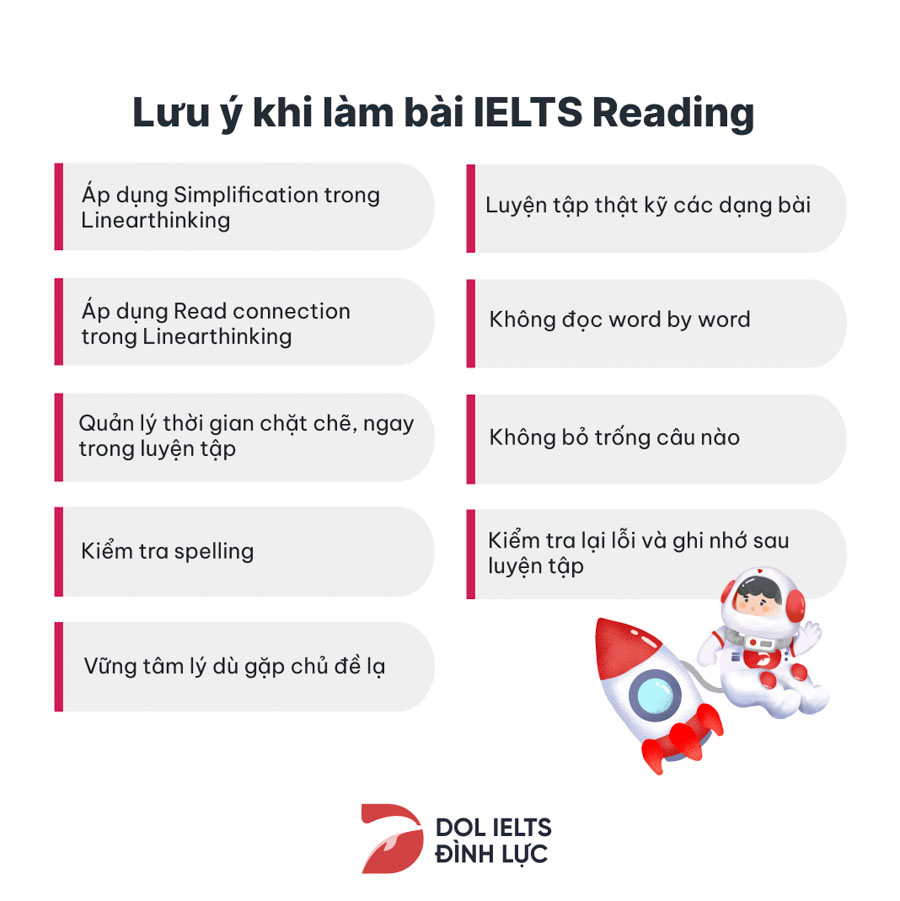
Lời kết
Trên đây là bài đọc reading "Advantages of public transport", hi vọng bạn làm bài thật tốt và cải thiện được khả năng từ vựng cũng như ngữ pháp để hỗ trợ nâng cao kỹ năng Reading IELTS của mình. DOL English hi vọng bạn sẽ nắm được toàn bộ các từ vựng hay và khó của tất các bài reading IELTS.
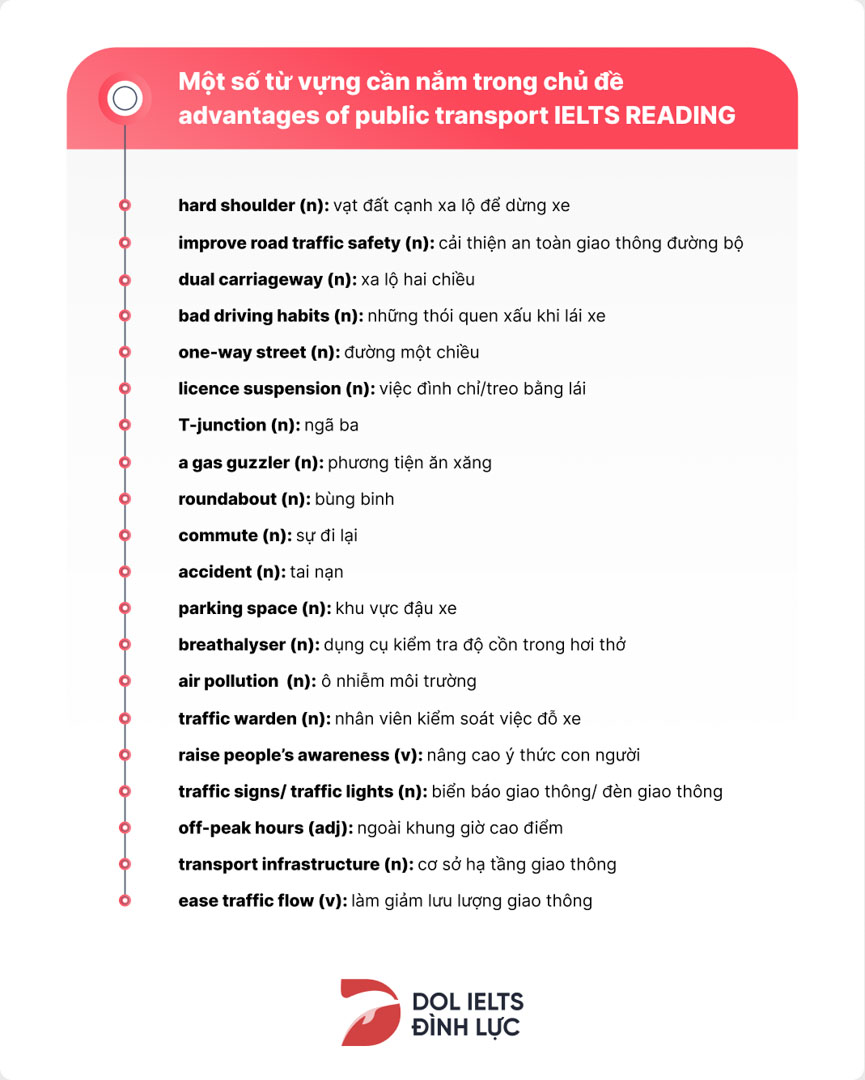
Câu hỏi thường gặp
Gợi ý bài luận IELTS: Ưu điểm của phương tiện công cộng là gì?
Ở các phương tiện công cộng hội tụ rất nhiều ưu điểm nổi bật. Cụ thể, nó giúp giảm tắc nghẽn ở các thành phố. Giá thành để tham gia phương tiện công cộng cũng rẻ hơn so với việc sở hữu và vận hành một chiếc ô tô, xe máy riêng.
Người sử dụng phương tiện công cộng cũng không còn phải chịu cảnh ùn tắc giao thông trong giờ cao điểm nhờ có các biện pháp phân làn dành riêng cho xe buýt hoặc ưu tiên phương tiện công cộng khác.
Gợi ý bài luận IELTS: Lợi ích lớn nhất của việc sử dụng phương tiện công cộng là gì?
Một lợi ích chính của việc sử dụng phương tiện giao thông công cộng là nó làm giảm số lượng phương tiện giao thông trên đường. Từ đó giảm thiểu khí thải từ xe cộ gây ô nhiễm môi trường và làm chậm quá trình ấm lên toàn cầu.
Gợi ý bài luận IELTS: Phương tiện công cộng là gì?
Giao thông công cộng, hay đơn giản là phương tiện công cộng là một hệ thống vận chuyển nhiều hành khách cùng 1 lúc từ nơi này đến nơi khác. Điển hình là xe buýt, tàu điện ngầm, xe lửa,...
Gợi ý bài luận IELTS: 5 tác động tích cực của giao thông vận tải là gì?
Giao thông vận tải giúp sản xuất hàng loạt và ổn định giá cả
Giao thông vận tải giúp phát triển kinh tế
Giao thông vận tải mang lại nhiều cơ hội cho con người
Giao thông vận tải giúp phát triển xã hội
Giao thông vận tải giúp phát triển công nghiệp và nông nghiệp
Table of content
Advantages of public transport
Answer key
Lời kết
Câu hỏi thường gặp

